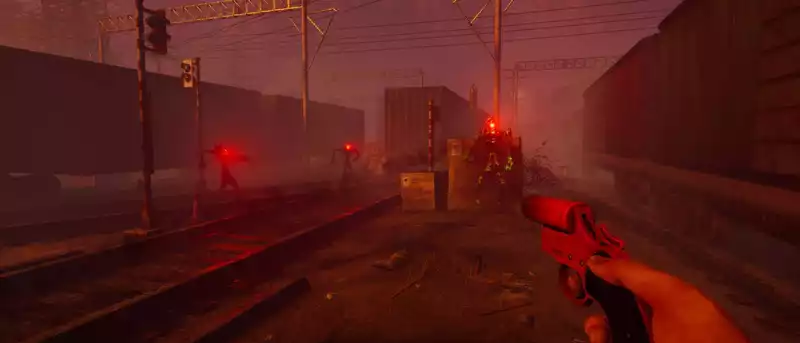"In Sound Mind" sometimes feels like traumatized characters having an identity crisis. The game doesn't know what it wants to be, but it tries to accomplish a lot. However, "In Sound Mind" is not all bad, and while there are some things it does poorly, there are some things it does really well.
About 10 minutes into "In Sound Mind," the main character, Desmond, says, "I'm not sure what I want to do. I'm not sure that I would have liked to have seen this film, because "In Sound Mind" is indeed strange, a convoluted mess of mechanics that don't work or aren't needed. Nevertheless, the game is still interesting and unsettling, thanks to its well-thought-out story and spine-tingling, frightening elements. Read the full review of In Sound Mind here.
In Sound Mind is a single-player psycho-horror game developed by We Create Stuff and published by Modus Games. The player takes on the role of Desmond Wales, a therapist who awakens in a post-apocalyptic dream world. Only by traversing nightmarish environments and unraveling a complex and traumatic plot in the process can you understand where you are, why you are there, and how to escape. Along the way, Desmond must explore psychologically distressing memories, battle evil enemies, and solve intractable puzzles.
At the beginning of the game, Desmond wakes up in a dank basement. From here, he must investigate his surroundings (how many floors of apartments) in order to figure out where he is and what is going on. To do this, he must delve into the memories and history of Desmond's most troubled patients.
You will teleport to different maps from portals located throughout the apartment. Each map is linear and follows a trail of voice recordings, clues, and challenges. You must explore the maps, fight enemies, sneak up on them, build weapons, solve puzzles, manage resources, find status upgrades, and seek out quest items. On the surface, there appears to be a lot to do. Unfortunately, many of these mechanics feel half-baked or pointless, or both.
First, one must deal with the enemy using either guns or stealth. Shooting works, but only to your advantage. The enemy consists of variations of the same black shape. They are difficult to hit and kill, and since there are only three different guns available, there are few variations to defeat them. In the beginning, just having a gun gives you more power, and managing ammunition is tricky. Overall, however, the gunplay is lackluster and does little more than keep you alive.
In Sound Mind's stealth mechanic is not great either. You basically just hide behind a box and walk around your enemies. It's simplistic, repetitive, and almost completely superfluous. To make matters worse, stealth is almost useless in most situations. Enemies can appear out of nowhere or hide behind objects. It is common to run into an enemy before you have the option of stealth. Similarly, environmental hazards must be destroyed periodically to open new map areas, which immediately alerts enemies in the vicinity. The lack of stealth implementation is a missed opportunity, as other titles in the genre, such as Alien: Isolation, have proven that stealth can be effective in increasing fear and tension.
Stealth also represents one of In Sound Mind's most troubling features: the introduction and immediate abandonment of mechanics. Crafting is another example. Early on, one must find parts all over the complex to build the first gun, which is an accomplishment. But the next gun is simply picked up in the room. The game basically stops crafting and there is no opportunity for this mechanic to shine further.
And then there's the perk system. Through "exploration" (poking around in the grass), Desmond's stamina and strength can be leveled up. In light of the previous systems, it is commendable that the perk system actually persists throughout the game. However, the perks do not visibly change the difficulty level, which makes them meaningless.
Fortunately, there are several gameplay elements that In Sound Mind excels at that help to make up for the shortcomings. Bosses, for example, are the antidote to tedious and unconventional combat. Boss fights usually avoid gunfire and instead require other tools. For example, one boss is challenged with a mirror, another with a floodlight. In one scenario, you have to fight a light bulb with a flare, and in the next, you have to dodge a bull skull on wheels. These scenarios provide the necessary variety.
There are also puzzles, but these are hit or miss. Many are too easy, requiring only a little running around and looking at something from a different angle. Others are tedious and repetitive, like going back and forth between fuse boxes to open one screw at a time. On balance, however, there are puzzles that are challenging, fun, and demanding enough to give one a sense of accomplishment when solved.
In Sound Mind excels at storytelling. The plot is complex and well crafted, with a tragic personal story of suicide, body dysmorphia, personality disorders, and domestic abuse, intertwined with a high-level government conspiracy. The game tells nothing early on and controls the pace through its structured chapters.
Nevertheless, "In Sound Mind" leaves no stone unturned in constantly throwing up enough clues to keep you guessing (and guessing). One can find notes left on the ground. We can read Desmond's files on each patient and guess what is going on. Some cats, like the muse, talk to you about the plot. The whole experience feels absorbing.
But most importantly, In Sound Mind is creepy. Truly eerie. There are things that are not in the least bit creepy: the gloomy hallways, the eerie lighting, the ominous voices calling you on the pay phone. But as the plot progresses, you get used to the classic horror elements. Then "In Sound Mind" builds psychological tension, combining delirious themes with subtle jump scares. Mannequins subtly change position as the camera moves, items appear where none existed, paths and doorways disappear, and the environment subtly changes. It is genuinely unsettling, making one want to question one's memory and sanity.
In Sound Mind was tested on both PC and Nintendo Switch; graphics performance on PC was decent. At the highest settings, the textures look a bit dated. For example, the gun skins look like they are straight out of an early 2000s war shooter, but the overall look of the game is not bad.
On the Switch, unfortunately, the graphics are scattered, with the drawing distance being the biggest annoyance; on the PC, looking out from the apartment into the waterlogged wasteland outside heightens the sense of desolation and despair. Similarly, while traversing the world, the monumental cassettes in the distance, lit up, give a sense of both scale and surrealism. Both visual elements are lost in Switch.
However, each platform makes good use of lighting and color. The limited use of light, combined with shades of red and purple, creates an ominous and bewitching mood that beautifully reflects Desmond's strange and depressing situation.
Music courtesy of YouTube music ensemble The Living Tombstone. The game opens with a dark, evocative piano melody that plays as the camera pans through the flooded world, followed by a haunting synth track that leads to the player's basement. Similarly, haunting sounds are inserted as the player encounters various floors, rooms, maps, and situations.
Sound effects also add to the mood. The sounds of rattling, clinking, and creaking can be heard mingling with the ambient noise, functioning as a mini-jump horror and instilling the sense that no matter where you are, you are not alone. The soundtrack is without a doubt the game's masterpiece.
In Sound Mind packs more mechanics than it can chew, but some of them are poorly done. Combat is tedious, stealth, crafting, and perks are practically non-existent.
However, some elements of In Sound Mind are favorably received. The complex plot is imaginative and interesting. The atmosphere is highly immersive, and the gameplay is both classically scary and psychologically unsettling.
If you're considering "In Sound Mind" for action-packed horror, intense stealth, or challenging puzzles, look elsewhere. But if you like games with compelling stories, scary experiences, and psychological suspense, "In Sound Mind" is well worth your time.
.









Comments